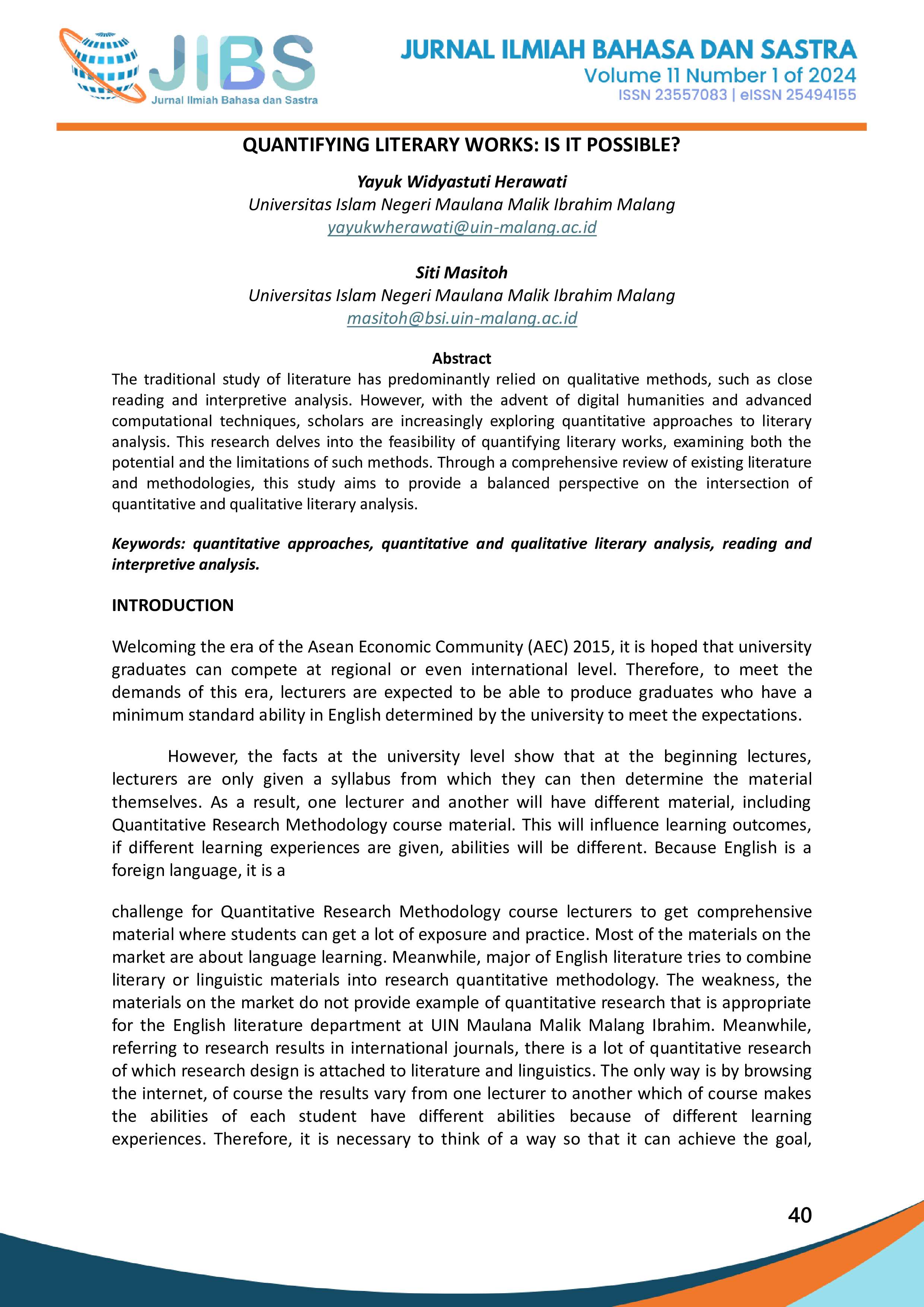QUANTIFYING LITERARY WORKS: IS IT POSSIBLE?
Main Article Content
Abstract
The traditional study of literature has predominantly relied on qualitative methods, such as close reading and interpretive analysis. However, with the advent of digital humanities and advanced computational techniques, scholars are increasingly exploring quantitative approaches to literary analysis. This research delves into the feasibility of quantifying literary works, examining both the potential and the limitations of such methods. Through a comprehensive review of existing literature and methodologies, this study aims to provide a balanced perspective on the intersection of quantitative and qualitative literary analysis.
Article Details

This work is licensed under a Creative Commons Attribution-NonCommercial-ShareAlike 4.0 International License.
JIBS (Jurnal Ilmiah Bahasa dan Sastra) allows readers to read, download, copy, distribute, print, search, or link to the full texts of its articles and allow readers to use them for any other lawful purpose. The journal allows the author(s) to hold the copyright without restrictions. Finally, the journal allows the author(s) to retain publishing rights without restrictions

This work is licensed under a Creative Commons Attribution-ShareAlike 2.0 Generic License.
References
Algavi, L., Volkova, I., Kadyrova, S., & Rastorgueva, N. (2021). Online literary creativity of digital natives: genre and thematic analysis. SHS Web of Conferences. https://doi.org/10.1051/shsconf/202110103048
Alli, O., & Ademola, W. (2019). A Linguistic (Stylistic) Reading of Ideological Discourse in Festus Iyayi’s Violence, The Contract and Heroes. Advances in Language and Literary Studies. https://doi.org/10.7575/aiac.alls.v.10n.1p.129
Anderson, C. W., & McMaster, G. E. (1986). Modeling emotional tone in stories using tension levels and categorical states. Computers and the Humanities. https://doi.org/10.1007/BF02393459
Anderson, J. A. (2011). A History of East Asia: From the Origins of Civilization to the Twenty-first Century (review). China Review International. https://doi.org/10.1353/cri.2011.0036
Apriyani, T., & Nalurita, B. A. Y. (2023). Nilai Kebangsaan pada Karya-Karya Leila S. Chudori. Diglosia: Jurnal Kajian Bahasa, Sastra, Dan Pengajarannya. https://doi.org/10.30872/diglosia.v6i2.594
Budhi, S. (2023). Pariwisata dan Identitas Perempuan Banjar: Suatu Analisis Sosiologi dalam Cerpen Gadis Pasar Terapung. Jurnal Sosiologi Andalas. https://doi.org/10.25077/jsa.9.1.79-89.2023
Chen, B., & Wang, Y. (2016). Character interaction network analysis of chinese literary work- A preliminary study. Proceedings of the Association for Information Science and Technology. https://doi.org/10.1002/pra2.2016.14505301088
Cinthya, N., & Wati, R. (2020). FENOMENA SASTRA CYBER: TREND BARU SASTRA ISLAMI DALAM MASYARAKAT MODERN DI INDONESIA. Jurnal Edukasi Khatulistiwa : Pembelajaran Bahasa Dan Sastra Indonesia. https://doi.org/10.26418/ekha.v3i1.37991
Dinsman, M., & Robinson, H. (2023). Dispatches from the home front: Violet Hunt as war writer and reluctant modernist. Feminist Modernist Studies. https://doi.org/10.1080/24692921.2023.2178782
Evans, M., & Hogarth, A. (2021). Stylistic palimpsests: Computational stylistic perspectives on precursory authorship in Aphra Behn’s drama. Digital Scholarship in the Humanities. https://doi.org/10.1093/llc/fqz085
Fan, C., & Li, Y. (2022). Network Extraction and Analysis of Character Relationships in Chinese Literary Works. Computational Intelligence and Neuroscience. https://doi.org/10.1155/2022/7295834
Fkih, F., Alsuhaibani, M., Rhouma, D., & Qamar, A. M. (2023). Novel Machine Learning–Based Approach for Arabic Text Classification Using Stylistic and Semantic Features. Computers, Materials and Continua. https://doi.org/10.32604/cmc.2023.035910
Gopal, R., & Lee, T. E. M. (2023). Reader Response Journals in The Analysis of Literary Works among Undergraduate Students. English Education Journal. https://doi.org/10.24815/eej.v14i1.30968
Haverals, W., Geybels, L., & Joosen, V. (2022). A style for every age: A stylometric inquiry into crosswriters for children, adolescents and adults. Language and Literature. https://doi.org/10.1177/09639470211072163
Hernández-Lorenzo, L. (2023). A first approach to literary genre in Cervantes’ works from Stylometry and Network Analysis. Tirant. https://doi.org/10.7203/TIRANT.26.27873
Holmes, I., Cribbin, T., & Ferenczi, N. (2023). Style over substance: A psychologically informed approach to feature selection and generalisability for author classification. Computers in Human Behavior Reports. https://doi.org/10.1016/j.chbr.2022.100267
Hudieb, F. (2021). Stylistic features in Ibn Al-Muqaffa’ al-Adab al-Sagheer and al-Adab al-Kabeer arguments. Dirasat: Human and Social Sciences.
Ikromovna Murodova, M. (2022). Satire: its nature and methods. Science and Education.
Khikhlushko, B. (2023). Author’s Being and Death: from Ancient Times to Postmodernism. LITERARY PROCESS: Methodology, Names, Trends. https://doi.org/10.28925/2412-2475.2023.21.12
Kotenko, O., Kosharna, N., Chepurna, M., Trebyk, O., & Bakhov, I. (2023). Linguistic and Stylistic Features of English Public Speeches. World Journal of English Language. https://doi.org/10.5430/wjel.v13n4p56
Marlina, M., Supriadi, D., Khomisah, K., & Karman, K. (2022). Belenggu Patriarki dalam Novel Perempuan-Perempuan Harem Karya Fatima Mernissi. Az-Zahra: Journal of Gender and Family Studies. https://doi.org/10.15575/azzahra.v3i1.14265
Misini, A., Kadriu, A., & Canhasi, E. (2024). Authorship classification techniques: Bridging textual domains and languages. International Journal on Information Technologies and Security. https://doi.org/10.59035/ukbe1226
Mudaghmesh, L., & Allawzi, A. (2023). Stylistic Features in the Translation of George Eliot’s The Lifted Veil into Arabic. Dirasat: Human and Social Sciences. https://doi.org/10.35516/hum.v50i4.5640
Quinault, D. L., & Jean Pierre, A. (2022). Assessing the Translatability of Emotional Discourse in Djaïli Amadou Amal’s Munyal “Les Larmes de La Patience. Traduction et Langues. https://doi.org/10.52919/translang.v21i2.912
Riobelle M., B., Famila N., J., Ana Rutchell D., S., & Lito L., D. (2023). GENDER OPPRESSION: THE YELLOW WALLPAPER BY CHARLOTTE PERKINS GILMAN. Cognizance Journal of Multidisciplinary Studies. https://doi.org/10.47760/cognizance.2023.v03i05.019
Sapchenko, L. A. (2023). Authorial notes to the text: an artistic device or an ego-document? Philology and Culture. https://doi.org/10.26907/2782-4756-2023-73-3-169-174
Schacherl, M. (2021). Sentence and the compound sentence in Julius Zeyer’s epic poetry and prose. Bohemistyka. https://doi.org/10.14746/BO.2021.3.2
Schouten, S. (2018). Anna M. Parkinson, An Emotional State: The Politics of Emotion in Postwar West German Culture . Cultural History. https://doi.org/10.3366/cult.2018.0180
Stockwell, P. (2015). Atmosphere and tone. In The Cambridge Handbook of Stylistics. https://doi.org/10.1017/CBO9781139237031.027
Syagina, E. I. (2022). Early works by Andrey Nemzer: To the problem of defining the author’s status. Izvestiya of Saratov University. Philology. Journalism. https://doi.org/10.18500/1817-7115-2022-22-2-186-191
van Hecke, A. (2024). Female literary Maps in Margo Glantz: a stylistic and thematic Analysis of Yo también me acuerdo (2014). America Sin Nombre. https://doi.org/10.14198/AMESN.24682
Zhang, C., Afzaal, M., Omar, A., & Altohami, W. M. A. (2023). A corpus-based analysis of the stylistic features of Chinese and American diplomatic discourse. Frontiers in Psychology. https://doi.org/10.3389/fpsyg.2023.1122675
Zhang, S. (2023). English-Chinese and Chinese-English Translations of Literary Texts: The Influence of Stylistic Features on the Translation Process and Eyetracking Technology. Journal of Psycholinguistic Research. https://doi.org/10.1007/s10936-023-10032-x
Zhang, Y. (2024). Analysis of artistic features of ancient Chinese literary works based on multi-scale feature fusion network. Applied Mathematics and Nonlinear Sciences. https://doi.org/10.2478/amns.2023.2.00287

